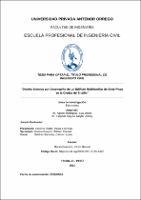| dc.contributor.advisor | Moran Guerrero, Víctor Manuel | |
| dc.contributor.author | Aguilar Rodríguez, Luis Dante | |
| dc.contributor.author | Esquivel Segura, Meyler Jimmy | |
| dc.creator | Aguilar Rodríguez, Luis Dante | |
| dc.date.accessioned | 2021-06-16T23:11:18Z | |
| dc.date.available | 2021-06-16T23:11:18Z | |
| dc.date.issued | 2021 | |
| dc.identifier.uri | https://hdl.handle.net/20.500.12759/7672 | |
| dc.description.abstract | El análisis y diseño por desempeño en estructuras en los últimos años se está
tomando con mayor importancia en nuestro país, es por ello que el presente
proyecto de tesis abarca conceptos básicos sobre los temas de análisis no lineal
tanto el estático como el dinámico para el diseño de estructuras de concreto
armado.
Este trabajo se desarrolló el análisis y diseño estructural de una edificación
destinada a viviendas multifamiliares de siete pisos más azotea. El cual aplicamos
las normativas del reglamento nacional de edificaciones para estructuras de
concreto armado.
Así mismo se buscó determinar el desempeño de la estructura aplicando la
metodología de análisis estático no lineal (PUSHOVER), el cual consiste en la
aplicación de fuerzas laterales a la edificación para luego obtener la curva de
capacidad y encontrar el punto de desempeño. Luego se sectorizó para los
diferentes niveles de peligro sísmico (Sismo Frecuente, Ocasional, Diseño y
Máximo). Siguiendo los parámetros de las normativas internaciones Visión 2000
(SEAOC), ATC-40. Con los métodos de FEMA 356, FEMA 440, ASCE 41-13.
También se obtuvo la ductilidad de la estructura a través de la representación
bilineal del espectro de capacidad.
Para encontrar el desempeño dinámico no lineal de la estructura se aplicó la
metodología de análisis dinámico incremental el cual se basa en aplicar sismos
reales en la base de la estructura mediante registros sísmicos escalados en un
intervalo de 0.5g a 10g. Para determinar los desplazamiento y derivas máximas en
el último nivel de la estructura, y graficar las curvas IDA.
El análisis incremental dinámico al dar respuestas determinísticas, necesitamos
adecuarlo de una manera probabilística, mediante la mediana geométrica (50 %) y
las medidas de dispersión (16 % y 84 % percentil) de la respuesta ante un cierto
nivel de demanda. Para cumplir con los objetivos de los diferentes niveles de
desempeño y el estado de daño de la estructura propuestos por el Visión 2000.
Al finalizar se realizó la comparación entre las metodólogas utilizadas para el
análisis, diseño y desempeño estructural | es_PE |
| dc.description.abstract | The analysis and design by performance in structures in recent years is becoming
more important in our country, that is why this thesis project covers basic concepts
on the topics of nonlinear analysis, both static and dynamic, for the design of
reinforced concrete structures.
This work developed the analysis and structural design of a building for multi-family
homes with seven floors plus a roof terrace. Which we apply the norms of the
national regulation of buildings for reinforced concrete structures.
Likewise, it was sought to determine the performance of the structure by applying
the nonlinear static analysis methodology (PUSHOVER), which consists of the
application of lateral forces to the building to then obtain the capacity curve and find
the performance point. Then it was sectorized for the different levels of seismic
danger (Frequent, Occasional, Design and Maximum Earthquake). Following the
parameters of the international regulations Vision 2000 (SEAOC), ATC-40. Using
the methods of FEMA 340, FEMA 440, ASCE 41-13. The ductility of the structure
was also obtained through the bilinear representation of the capacity spectrum.
To find the non-linear dynamic performance of the structure, the incremental
dynamic analysis methodology was applied, which is based on applying real
earthquakes at the base of the structure through seismic records scaled in an
interval from 0.5g to 10g. To determine the maximum displacement and drifts in the
last level of the structure, and to graph the IDA curves.
The dynamic incremental analysis when giving deterministic responses, we need to
adapt it in a probabilistic way, by means of the geometric median (50%) and the
dispersion measures (16% and 84% percentile) of the response to a certain level of
demand. To meet the objectives of the different levels of performance and the state
of damage of the structure proposed by Vision 2000.
At the end, a comparison was made between the methodologists used for the
analysis, design and structural performance | en_US |
| dc.description.uri | Tesis | es_PE |
| dc.format | application/pdf | es_PE |
| dc.language.iso | spa | es_PE |
| dc.publisher | Universidad Privada Antenor Orrego | es_PE |
| dc.relation.ispartofseries | T_CIVIL_1951 | |
| dc.rights | info:eu-repo/semantics/embargoedAccess | es_PE |
| dc.rights.uri | https://creativecommons.org/licenses/by/4.0/ | es_PE |
| dc.source | Universidad Privada Antenor Orrego | es_PE |
| dc.source | Repositorio Institucional - UPAO | es_PE |
| dc.subject | Sísmico | es_PE |
| dc.subject | Multifamiliar | es_PE |
| dc.title | Diseño sísmico por desempeño de un edificio multifamiliar de siete pisos en la ciudad de Trujillo | es_PE |
| dc.type | info:eu-repo/semantics/bachelorThesis | es_PE |
| thesis.degree.level | Título Profesional | es_PE |
| thesis.degree.grantor | Universidad Privada Antenor Orrego. Facultad de Ingeniería | es_PE |
| thesis.degree.name | Ingeniero Civil | es_PE |
| thesis.degree.discipline | Ingeniería Civil | es_PE |
| dc.subject.ocde | https://purl.org/pe-repo/ocde/ford#2.01.00 | es_PE |
| renati.advisor.orcid | https://orcid.org/0000-0001-8125-7462 | es_PE |
| renati.author.dni | 47373661 | |
| renati.author.dni | 46782097 | |
| renati.advisor.dni | 60241113 | |
| renati.type | https://purl.org/pe-repo/renati/type#tesis | es_PE |
| renati.level | https://purl.org/pe-repo/renati/level#tituloProfesional | es_PE |
| renati.discipline | 732016 | es_PE |
| renati.juror | Cancino Rodas, César Leónidas | |
| renati.juror | Galicia Guarniz, William Conrad | |
| renati.juror | Geldres Sánchez, Carmen Lucia | |
| dc.publisher.country | PE | es_PE |
| dc.date.embargoEnd | 2022-06-15 | |


